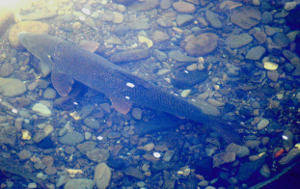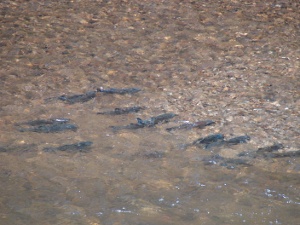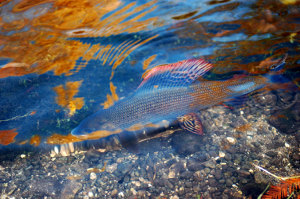Other Fish Species



(Fishing from a canoe is illegal unless you have an EA rod licence AND the permission of every fishery owner)
Apart from salmon, shad and sea lamprey, which are covered elsewhere in this section, both rivers support a variety of other fish species. The Usk is famous for its wild brown trout, which inhabit most of the river’s length. The upper reaches of the Wye also holds good populations of trout but unless you are exceptionally stealthy, seeing this wary species from a canoe will usually be limited to when they are feeding on insects off the water’s surface, or to the occasional fish bolting through the shallows for cover.
The Wye is also one of the best rivers in the country for grayling (they are not in the Usk), a fish identifiable by its iridescently marked dorsal fin. The upper reaches the best part of the river for them. They are not as wary as trout but can also be difficult to see by canoe, however.
Barbel and chub, both members of the carp family, are probably the fish species most commonly seen mid-river from canoes. They inhabit both rivers, although they are more prevalent in the canoeable sections of the Wye where they often gather in large shoals. The powerful barbel grows to be quite large in size and can be identified by their coral coloured pectoral fins. They were introduced into the Wye and Usk from the Severn in the 1950s and 1960s, so are not recognised as a native species. Chub grow to around two feet long and, like barbel, often show themselves in a bronze flash on the bottom of the river when feeding. They can also often be seen basking near the surface in the slower sections of river. Approach these areas quietly and you may catch a glimpse of a chub sunning itself before it makes for cover. By doing so, you may also come across one of the ever- increasing numbers of carp in the Wye, another relative newcomer to the river, most having escaped from nearby ponds that have flooded.
The Wye is also known for its pike, the largest of which weighed 39lb and was caught in the river around Hay. Like perch, another Wye predator, they are well camouflaged and wait in ambush of smaller fish in tree roots and other cover, so spotting them can be difficult. Large shoals of dace inhabit both rivers, along with roach, bullhead and loach. However, probably the easiest fish species to see are when boarding your canoe - the rivers' margins teem with large shoals of minnow and gudgeon, along with the fry (juveniles) of all the other species.
Trout spawn in the late autumn and winter, usually in small tributary streams. Most of the other species mentioned here spawn in the main stem of the river between March and July, so please be careful not to disturb shoals of fish during these months.
